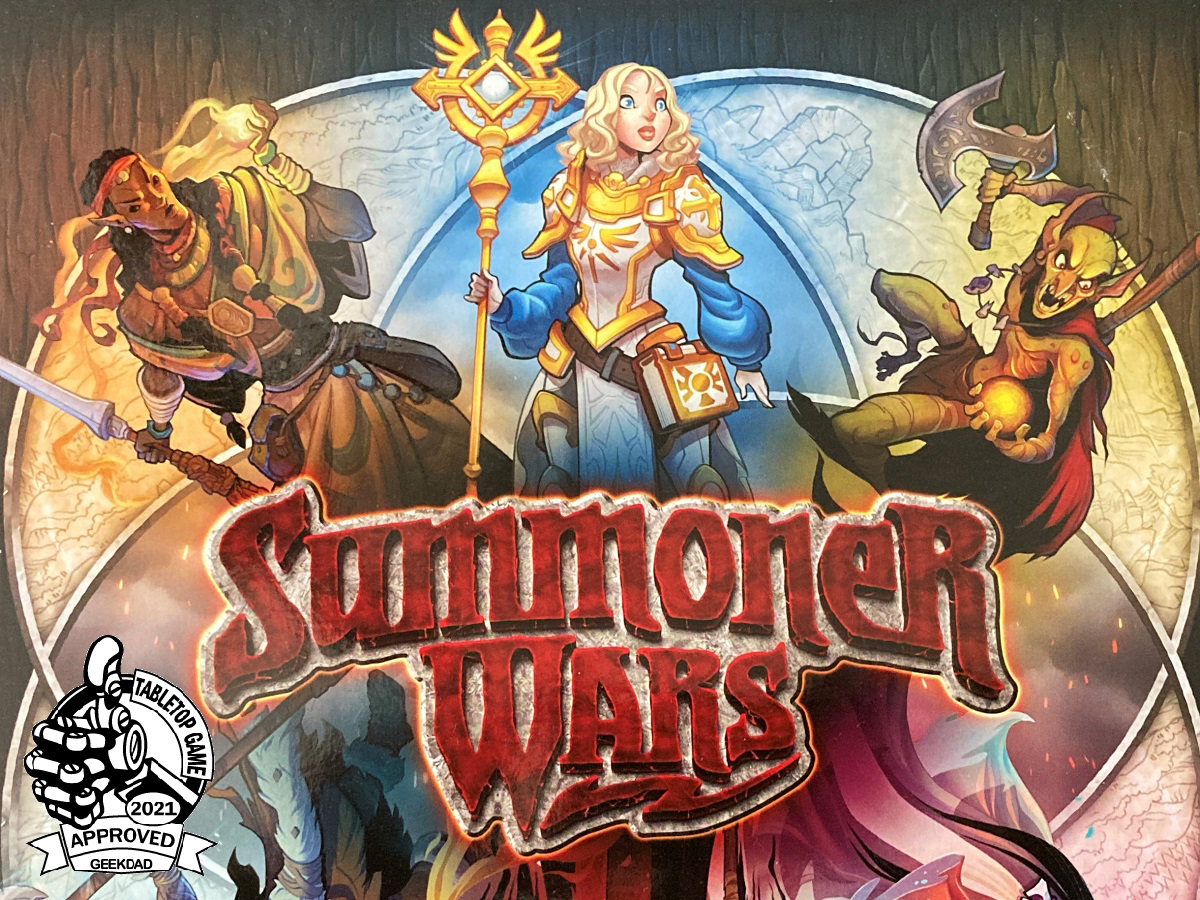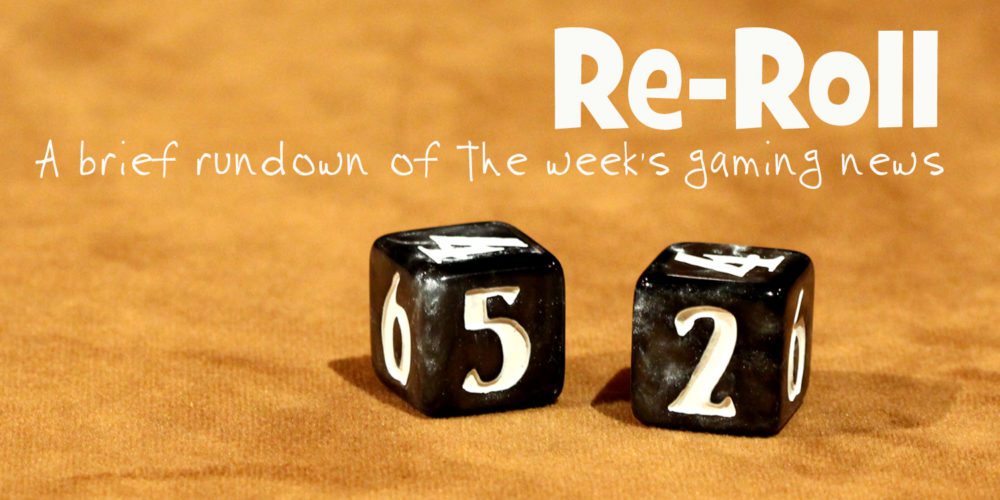The first summoning stone was found by the lord of the Fallen Kingdom, Ret-Talus. For a thousand years, Ret-talus used the power of the stone to wreak havoc on the world of Itharia and defeat any army sent to stop him. However, after a millennia, a second stone was found by Dane Lightbringer who also became a summoner and was able to help keep the power of Ret-Talus in check. Over time, more stones were discovered and new summoners created. Rather than rallying together against a common threat, these summoners instead focuses on their own faction and fought among themselves giving rise to the Summoner Wars.
What Is Summoner Wars?
Summoner Wars is an expandable card game for 2 players, ages 9 and up, and takes about 40-60 minutes to play. In this game, players take on the role of summoners in a duel where they summon their army onto the battlefield, cast spells, and move their units into combat in order to defeat their opponent. Summoner Wars: Second Edition Master Set is currently available from most FLGS, online retailers such as Amazon, and directly from the publisher with a suggest retail price of $50. Summoner Wars was designed by Colby Dauch and published by Plaid Hat Games, with illustrations by Martin Abel and Madison Johnson. The first edition was released in 2009. However, the second edition contains new art and features revised and perfected rules which clarify some of the earlier confusion and makes the game a bit easier to play.
Summoner Wars: Second Edition Master Set comes with six different factions. In order to get additional factions, a subscription service is available. Four times a year, two new factions will be released for $29.95 per release with shipping included. This is a great way to add to your collection and get the new factions before they are available for retail sale. You can also subscribe to the online version of Summoner Wars for $2.95 per month which gives you access to all factions.
Summoner Wars Components
Here is what you get in the Summoner Wars: Second Edition Master Set:
- 204 Cards (6 Faction Decks)
- 8 Custom Dice
- 1 Battlefield Game Board
- 36 Tokens
- Rulebook
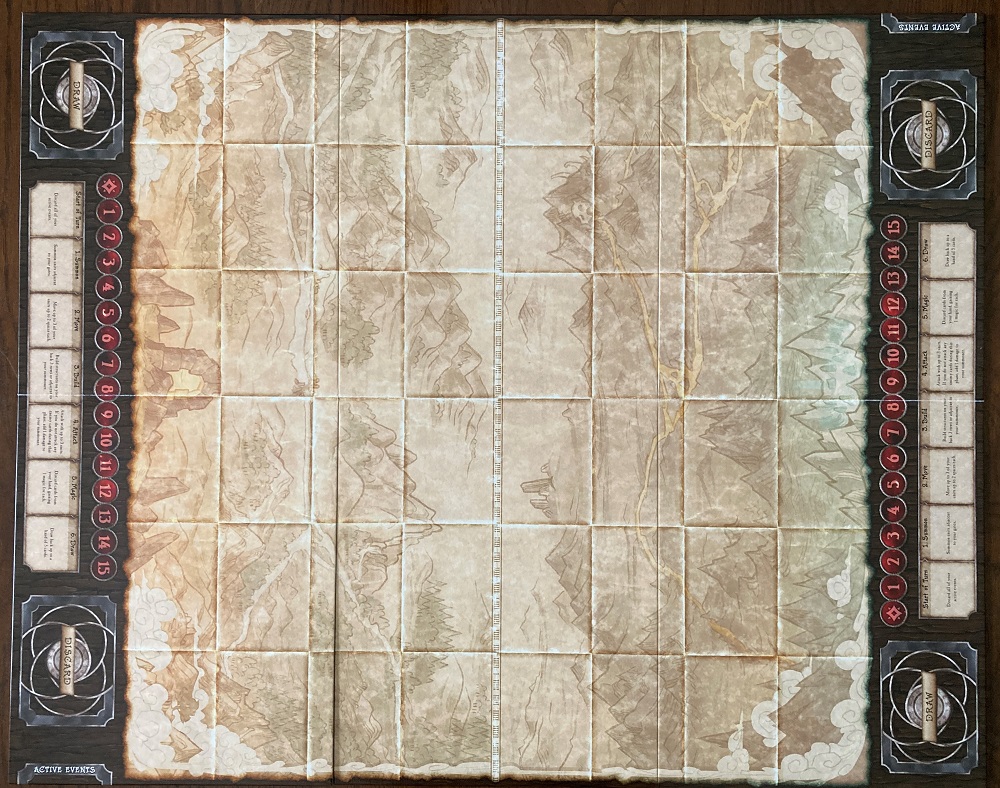
The battlefield for Summoner Wars consists of a 6 x 8 grid of 48 spaces where cards can be positioned. The sides of the gameboard has spaces for each player’s draw and discard piles, a track for magic, and even brief descriptions of the phases which make up a player’s turn.
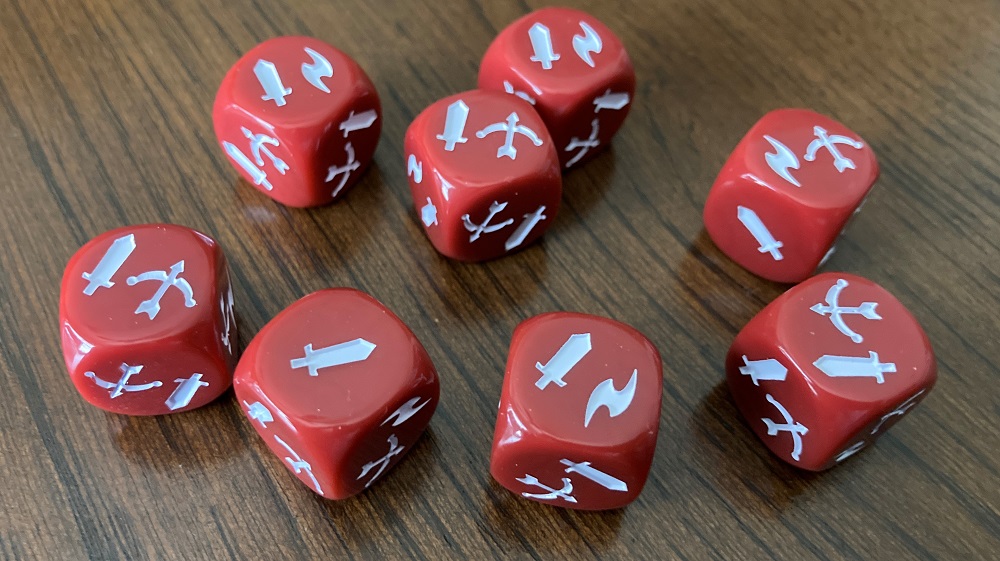
The eight custom dice feature one or two symbols on each face which include a sword (melee attack), bow and arrow (ranged attack), and a swish (special as defined on a unit’s card). There are swords on five of the sides, bow and arrow on four of the sides, and a swish on only two sides.
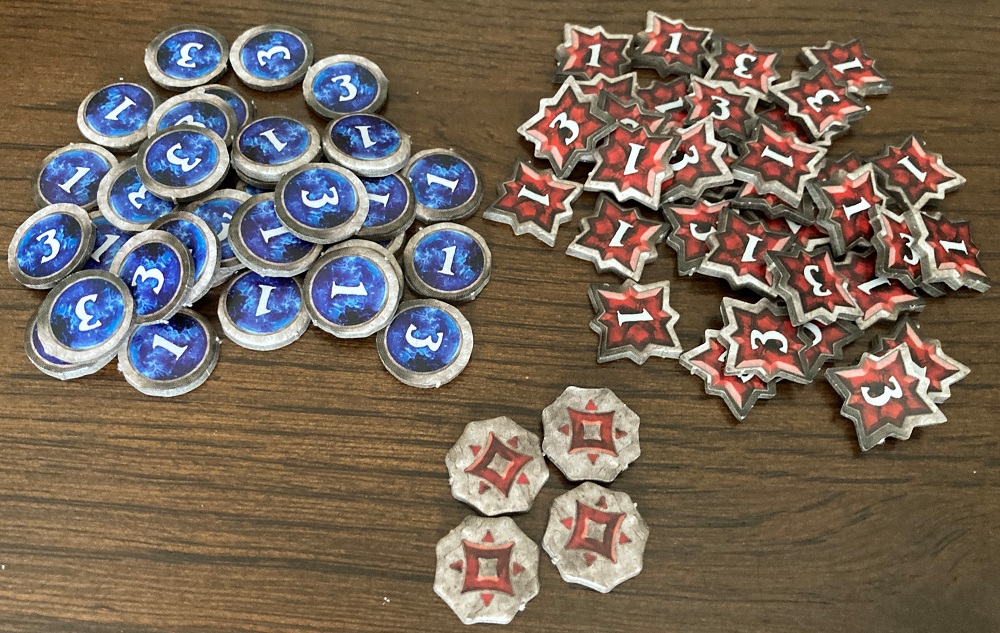
There are three types of tokens included in the game. Magic tokens are used to keep track of a player’s magic on the magic track. Damage tokens are placed on cards in play to show the amount of damage they have sustained. Finally, boost tokens are used to represent bonus abilities or features as defined on a card. These often increase a unit’s attack or movement values.
The Summoner Factions
The Summoner Wars Second Edition Master Set comes with six complete factions which ready to play right out of the box. Each faction consists of a summoner, 3 champions, 4 different commons units (4-5 copies of each), 1 epic event (2 copies), and 3 standard events (2 copies each). Here is a look at the factions.
Breakers
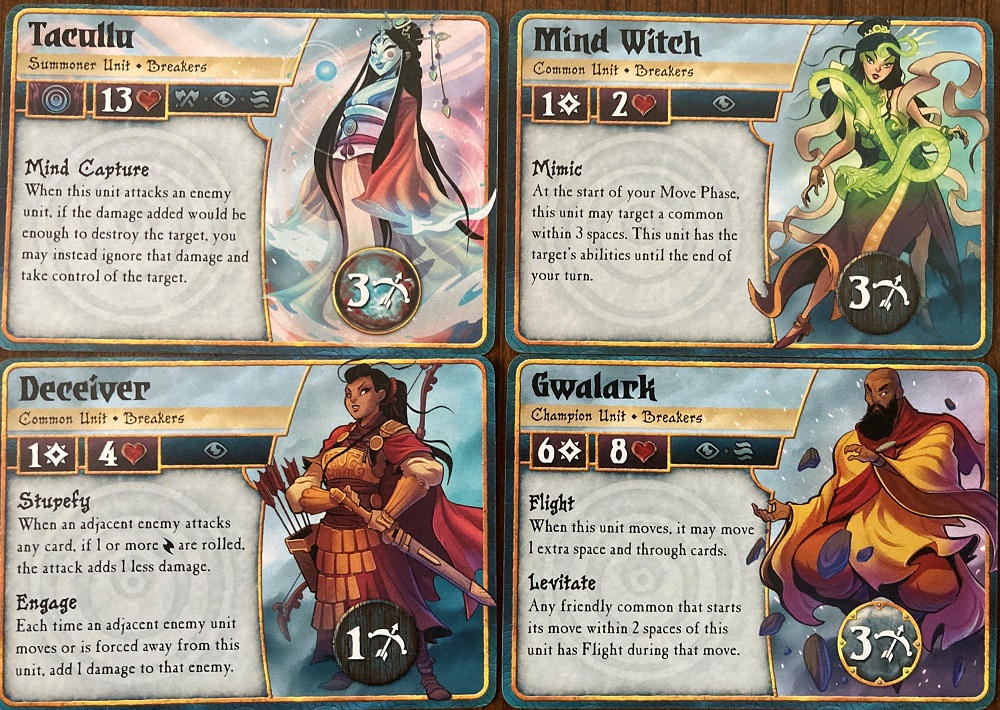
Tacullu is the Breakers’ summoner. Her ability allows you to take control of enemy units she attacks if they would receive enough damage to destroy them. The Breakers only have one champion unit with a melee attack. All the rest have ranged attacks. Many of the unit abilities and events revolve around extra movement and forcing other units, including enemy units, to move. The extra mobility can help move Breaker units into firing range and keep them away from melee attackers.
Cave Goblins

The Cave Goblins’ summoner, Sneeks, can change places with some friendly units during the attack phase, which can pull him out of danger after an attack. This faction has only one champion and one common unit with ranged attacks. The rest are melee attackers. However, what sets this faction apart is that only one champion unit and one common unit cost magic to summon. The rest have a cost of 0 to summon allowing this faction to summon a lot of units. However, 2 of the champion units require you to spend magic each turn or they are damaged or discarded. Some units also allow you to use them as an extra attack in addition to the three you get each turn. The downside of this faction is that most of its units have low life values and can be easily destroyed.
Fallen Kingdom

Ret-Talus, the first summoner, is the leader of the Fallen Kingdom. Once per turn he can take 2 damage to retrieve an Undead unit from the discard pile and place it on a space next to him. This faction has a good balance between melee and ranged units. Several of the abilities and events require sacrificing or inflicting damage on friendly units to increase strength, to heal, or to summon other units. This is definitely an interesting faction to play as.
Polar Dwarves

Svara leads the Polar Dwarves and can force a friendly structure to move one space after she moves. In fact, many of this factions’ abilities are related to structures. Some gain strength from structures while others give an extra life to structures. One common unit, the Ice Golem, is actually a mobile structure and can act as a gate for summoning units. All of the events affect structures as well.
Savanna Elves

Abua Shi is the summoner for the Savanna Elves and has the ability to boost other units. In fact, this faction is all about boosting. Boosting increases the life of some units while increasing movement of others. Boosting can increase damage as well. A couple units can even spend boosts to make an second attack with that unit. The key to playing this faction is understanding how to add boost tokens to units and how the abilities and events use the boosts.
Vanguards
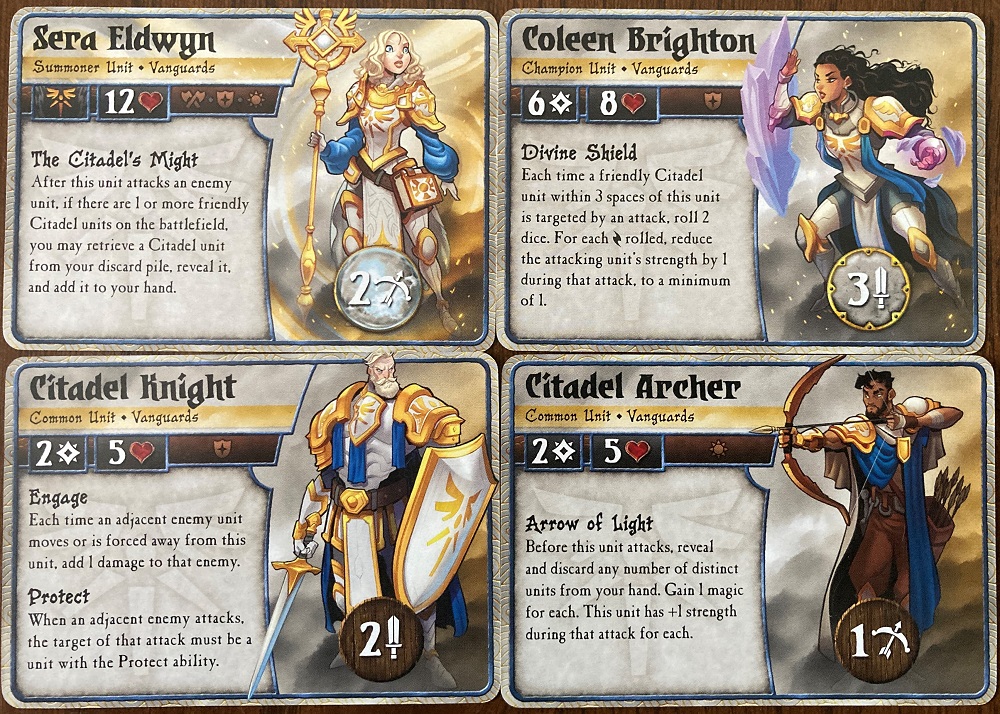
Led by Sera Eldwyn, the Vanguards focus primarily on melee attacks and have high health values, even for most of their common units. Some units and events allow healing of units with damage. Unit abilities also allow for gaining magic and magic can even increase some units’ strength. Sera’s ability allows her to retrieve some types of common units from the discard pile and put them back into the player’s hand.
How to Play Summoner Wars
You can download a copy of the rulebook here.
The Goal
The goal of the game is call forth an army of warriors, maneuver them around the battlefield and destroy the opponent’s summoner.
Setup
Start off by placing the battlefield gameboard between the two players. Make two piles of tokens, one for damage and one for boost, located within easy reach of both players. Next each player picks a faction deck to play or creates their own custom deck. The back of each summoner card shows where to place the summoner, the two starting units, and the starting gate on the battlefield. Players then shuffle their remaining cards and place them face down to form a draw pile on the designated space on the gameboard. Each player draws five cards from their draw piles to form their starting hand. After randomly determining which player will go first, the first player places their magic token on the 2 space in their magic track on the gameboard while the second player places their magic token in the 3 space. You are now ready to begin play.
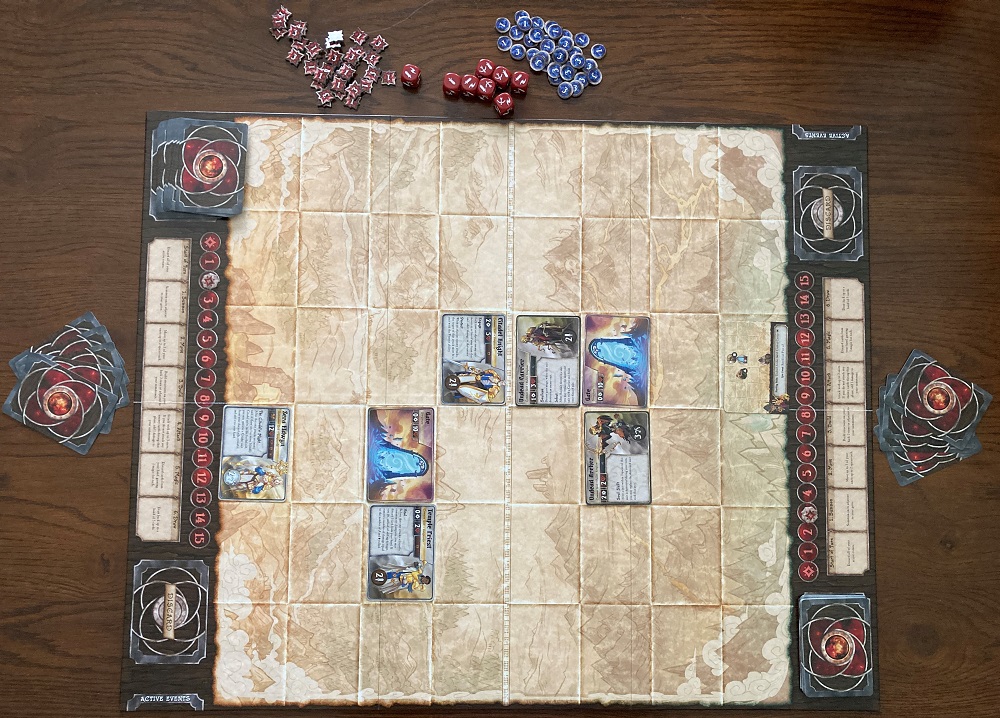
Gameplay
Players alternate taking turns until the game is over. During each turn, a player completes six different phases in order. Here is what you do during each phase.
Summon
During the first phase, a player can summon any number of units to the battlefield from their hand. To do this, locate the summoning cost of the unit and pay that amount in magic. Then place the unit on a space orthogonally adjacent (not diagonal) to a gate you control that does not have a unit already on it.
Move
Once a player has summoned their units, they can then move up to 3 different units which they control on the battlefield. Units can move one or two adjacent spaces. They cannot move diagonally and cannot move through other units whether they are friendly or enemy. A structure cannot move unless an effect allows it to move. Also, a unit can move into one space and then back into the same space in order to trigger an ability that requires movement. Some units have the ability to move more than 2 spaces. These are explained on their unit cards.
Build
After moving up to three units, the active player can then build a structure. Select a structure from your hand, pay its cost in magic, and then place it on the battlefield. Structures can be placed anywhere in the back three rows on your side of the battlefield or adjacent to your summoner.
Attack
During the attack phase, you can attack with up to three different units. They do not need to be the same units which moved. Start off by declaring a target. For melee attacks, with the sword symbol, the target must be adjacent to the attacking unit. For ranged attacks, with the bow and arrow symbol, you can attack targets up to three clear spaces away. They cannot fire through or over other units. After a target has been selected, roll a number of dice equal to the unit’s attack value. Add up the number of symbols on the dice that match the type of attack and inflict that much damage on the target by placing damage tokens on it. If the amount of damage on a unit equals or exceeds its life, then the unit is destroyed. Place the unit card, and any other cards under it, face down on top of the owning player’s discard pile. If you did not target an enemy unit with an attack this turn, then you must add 1 damage to your summoner. There is a price for inaction. Finally, each time a card you control destroys an enemy card, you gain 1 magic.
Magic
This is where you can gain magic. You may discard any number of cards from your hand and gain 1 magic for each card.
Draw
If you have fewer than five cards in your hand, then draw cards so you hand is back up to five. If your draw pile ever runs out of cards, you can no longer draw cards. You do not get to use your discarded cards for a new draw pile.
Event Cards
Event cards are a bit unique. They may be played during any phase listed on the card. In order to play an event card, pay the cost, resolve its effect, and then discard it. Event cards cannot be played while a game effect is being resolved. Some event cards have the word ‘Active’ on them. They have an effect that continues for a period of time. When played, placed it in the active area on the side of the gameboard. Then at the start of your next turn, discard all active events in your active area.
Game End
The game ends when one player’s summoner has had its life decreased to zero and is defeated. The player with the surviving summoner is the winner.
Summoner Wars Second Edition is GeekDad Approved!
Why You Should Play Summoner Wars
The revised rules for Summoner Wars Second Edition really make the game better. The order of the phases have changed. There is no longer a phase for using event cards. Instead, event cards are used during phases listed on the cards themselves. Also, magic is now tracked with a token on the gameboard rather than through cards. As a result of these changes, the rules are a bit more streamlined. Furthermore, changes have been made to the values of each unit and the abilities within a faction have been revised to create more synergy within the faction.
The rules of Summoner Wars are very straightforward and make the game easy to learn. It can also be taught to other players without any difficulty. The directions for each phase of a turn is printed right on the gameboard. In fact, after a few minutes of explanation on how to move and attack, start playing and learn as you go. As players become more familiar with the game’s rules and their faction’s units and abilities, you can often get in 2-3 games during a session as you let players try different factions or better learn how to play a single faction.

Summoner Wars has two factors that I really like in a game. First, I like games with cards featuring quality art on them as well as text which adds to the rules without adding to the rulebook itself. this provides greater depth to the game and lets players focus on only the rules that apply directly to the cards in their hand. Second, I like themed factions with unique abilities that require different tactics and strategies. I mentioned earlier how the new edition of the game revised the cards so that those within a faction work have abilities that not only reflect a theme of the faction, but also allow for more interaction within the faction. For example, the Savanna Elves are focused on boosting. The Lioness gains a boost when it attacks an enemy unit and also has +1 life for each boost token on it. The Rhinoceros gains +1 movement for each boost token on it. The Spirit Mage gets a boost when it is summoned and each time it moves, it can gain a boost or give a boost token to a friendly unit. Some of the effects give boosts to units and even the faction summoner, Abua Shi, has the ability to boost a friendly target and give all the boost tokens on the summoner’s card to that unit.
While unit cards form the majority of your deck, event cards also play an important role. Think of these like spells you can cast. Some take place instantly and deliver damage, heal units, or force units to move. Other event cards which have the keyword Active on them last until the start of your next turn. For example, Guarding Spirits from the Vanguards faction affects friendly common units within 3 spaces of your summoner. While active, those units take no more than one damage when they are attacked. Since active events only last one turn, part of the strategy is to time their use to maximize their effects.

Another reason I am impressed by Summoner Wars is that it encourages players to stay engaged and on the attack rather than just sitting back and building up an army. Since you can only move 3 units and attack with 3 units each turn, there is not much advantage to building up a large army on the battlefield. Plus, if you don’t attack during a turn, your summoner takes a point of damage! The fact that once your draw pile is empty you don’t shuffle your discard pile to make a new draw pile adds a time limit to the game in effect. Plus, since you can gain magic by discarding cards in your hand during the magic phase, you may have to get rid of some cards in order to obtain enough magic to summon a champion or other powerful unit which have a high summoning cost. Therefore, as you play, you are looking at both your draw pile and magic tracker as well as those of your opponent.
With six different factions, there is a lot of replayability in this game. In addition, players can also create their own decks by mixing cards from different factions within the guidelines of the rules. You can only have 1 summoner, 3 champions, and so many common units. This keeps custom armies balanced. Don’t forget the events in your deck. Each summoner has two epic events that must be included in their army. However, you can pick any 6 standard events to add as well. Creating your own army can be a lot of fun in itself. Start off with just combining two factions so you can keep some of the synergy within these factions. Then test out your new army and see how it works on the battlefield.
Finally, I really like that every single unit has their own ability. Most games have their powerful units with cool abilities and then just basic units that act as cannon fodder. There are no generic or filler units with just attack and life values in Summoner Wars. Each has some way of interacting with other units or the game itself. As a result, it can sometimes be difficult to sacrifice a unit since you also lose that unit’s ability.
Even when I have no one to play against, I get out a faction deck and study the units, create tactics for using their abilities, and form strategies for taking on opposing factions. Plaid Hat Games also offers their online version of the game. Even if you don’t subscribe, they always have two factions available to play for free and you can play against the AI or another player. This is a great way to practice and learn the game while testing out tactics.
I thoroughly enjoy playing Summoner Wars and highly recommend it for anyone who likes card-based games that require some strategy and offer a lot of variety. For the many reasons I have shared, Summoner Wars Second Edition is GeekDad Approved.
For more information, visit the Summoner Wars page. You can play on online demo of the game here!
Click here to see all our tabletop game reviews.
![]() To subscribe to GeekDad’s tabletop gaming coverage, please copy this link and add it to your RSS reader.
To subscribe to GeekDad’s tabletop gaming coverage, please copy this link and add it to your RSS reader.
Disclosure: GeekDad received a copy of this game for review purposes.
